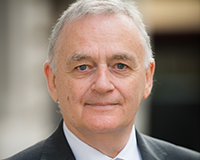The fact that Grosvenor obliges each operating company to imagine the worst every month came as a mild shock during a chat with finance director Nick Scarles (13 February, p26).
There can be few property companies that require managers to regularly imagine a 40% fall in asset values, especially a business that owns £6bn of property and runs a £11.4bn global fund management operation.
The second shock was Scarles’ frankness. How many listed companies – or global fund managers – would share these dark details?
But that’s sort of the point. Grosvenor can afford to speak out, and in doing so, does a service to those that can’t. The fresh-faced 53-year-old is careful not to say when a downturn might occur.
Scarles delivers one mildly shocking piece of advice with his trademark steady gaze, delivered by a man whose experience was shaped as head of risk at Centrica, after the gas extraction, pipeline and supply monopoly of British Gas was broken in 1997. He said: “You need to know what will make you go bust. If you don’t, you don’t understand the risks.
“Our gearing limits are set to withstand a one in 50- to 100-year crash,” he says. Grosvenor uses “economic gearing”, which includes joint ventures and funds. Using this metric, debt-to-asset levels have ranged between 20-40% in the past few years, says Scarles, who adds: “This means our holding company debt covenants can withstand a decline in excess of 60%.”
Caution pays. “In 2006 we looked at the early ’90s and early ’70s downturns. We had a good idea of what a crash could do.” In the 2007-08 crash our equity value fell by 16%. In the listed sector it was 55%.”
On the square
And now an unrelated Grosvenor tale. A cautious statement on the future of its eponymous square comes after it was whispered that it plans to seize back the management from the Royal Parks.
“There have been initial talks between the Royal Parks and Grosvenor on management changes. However, changes are not imminent and would be subject to parliamentary approval.” Careful now.
But one big change looms, says someone who has seen architect David Chipperfield’s plans for remodelling the US embassy. A new floor is to be added, flush with the existing façade, as part of a plan to create a hotel and flats behind.
Sky-high praise
Something unrecorded in the modern history of property has happened. Not one, but two skyscrapers have been built and (nearly) filled in one cycle. Credit goes to LandSec’s Rob Noel for the Walkie Talkie and Chris Grigg of British Land for the Cheesegrater, both EC3.
Both projects endured years in planning purgatory before either chief executive was in post. But pressing the construction buttons in 2010-11 took some nerve, even though both gave 50% to jv partners. Each tower is now worth several hundred million pounds more than anticipated five years ago. Can the pair pull off one final trick: crystallise that profit by selling before the next downturn?
Builder’s rubbish
Spot the flaw in George Osborne’s “we are the builders now” declaration. On 4 February the government published details of 598ha of surplus public sector land for sale in 80 locations “as part of a drive to deliver tens of thousands of new homes”. On 25 January the National Audit Office said 200 homes had been built on public land sold between 2011 and 2015 “despite selling enough to build 109,500 properties”.
Treasured memory
I sat opposite a national treasure at a charity dinner in February 2010. Not at the top table, but halfway down a line of refectory benches in one of the Inns of Court. The NT had come as a guest of Anthony Ratcliffe, who runs a small and sound property syndication business. The NT had come as his friend, despite a knee operation two weeks earlier.
The NT willingly took the pencil to score the charity quiz and joshed the evening away. He limped away smiling, barely noticed, aided by an elegant cane. The national treasure was, of course, Sir Terry Wogan.











